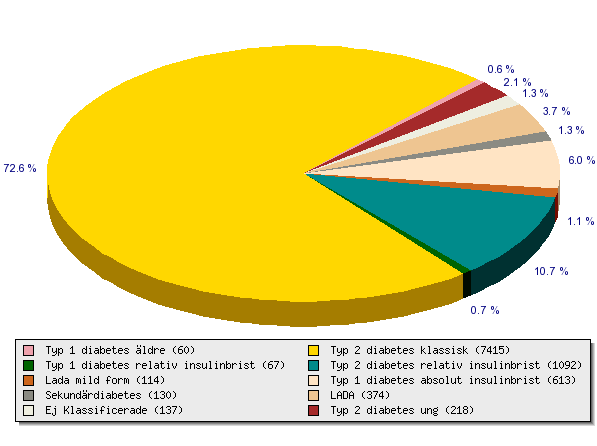Types of diabetes
Diabetes is a common disease; seven per cent of the adult Swedish population suffer from it [1]. It is also one of the fastest growing diseases around the world. According to estimations made by the World Health Organisation (WHO), the global prevalence has doubled since the 1980´s and the number of people living with diabetes has increased four-fold [2].

Diabetes is usually divided into type 1 diabetes, mainly affecting children, and type 2 diabetes, primarily affecting adults. However, diabetes includes several different diseases, all characterised by elevated blood sugar levels as a result of decreased insulin production, impaired insulin uptake, or both. In fact, the researchers behind the ANDIS and ANDiU registries, from which the ESTRID study recruits its participants, suggest a more nuanced picture of diabetes with five different categories of diabetes affecting adults [3].
One reason why diabetes has increased worldwide may be that sedentary lifestyles and overweight have become more common. However, this does not fully explain the increase, indicating that additional factors must be involved. Diabetes is a lifelong disease which, in the long run, can lead to complications affecting the eyes, kidneys, heart and blood vessels. With the division of diabetes into more specific categories, patients will hopefully be offered a more individually adapted health care. Read more about the different types of diabetes on the ANDIS webpage.
LADA
LADA (latent autoimmune diabetes in adults) is a type of diabetes with onset in adult years and is characterised by similar features to both type 1 and type 2 diabetes. According to the ANDIS registry at Lund University, LADA comprises around five per cent of all diabetes cases in adults, which makes it more common than type 1 diabetes among adults [4]. Both LADA and type 1 are autoimmune diseases. However, the progression to autoimmunity is slower and, unlike type 1 patients, LADA patients can often manage without insulin for a while [5]. LADA also has features of type 2 diabetes, such as disease onset in adults and that it is characterised by impaired insulin sensitivity [6].
Type 2
Type 2 diabetes is hereditary, but the risk of developing the disease is also affected by lifestyle factors [7]. This type of diabetes is mainly characterised by an impaired insulin sensitivity, so-called insulin resistance, which can emerge as a result of risk factors such as overweight, a sedentary lifestyle or smoking, to name a few. People with heredity in combination with one or several risk factors suffer a particularly increased risk of developing the disease. Type 2 diabetes constitutes around 85 % of all diabetes [2].
Type 1
Type 1 diabetes is, like LADA, an autoimmune disease where the body's own immune system attacks the insulin producing cells in the pancreas. The result is a cessation of insulin production, resulting in the requirement of insulin treatment for people with type 1 diabetes. The disease is hereditary but environmental factors are believed to be of importance for the development as well. There are few known risk factors for type 1 diabetes, but viral infections in early life are believed to increase the risk.
Facts about LADA and type 2 diabetes
- Type 2 diabetes primarily develops in adults, but it is also prevalent among younger persons.
- The onset of LADA is in adulthood. One criterion for both LADA and type 2 patients in the ESTRID study is having turned 35 years of age no later than the day of registration in the ANDIS or ANDiU registry.
- Type 2 diabetes is characterised by insulin resistance, which implies that the cells' lose their ability to react to the insulin produced in the pancreas.
- LADA is characterised by features of both type 1 and type 2 diabetes. Like type 1 diabetes, it is an autoimmune disease, which means that the body's immune system attacks the insulin producing cells, resulting in insulin deficiency. LADA is also characterised by some level of insulin resistance.
- The antibodies attacking the insulin producing cells are called GADA and are prevalent in both LADA and type 1 patients, but not in type 2 patients. LADA patients can have a higher or lower level of these antibodies. A higher level makes the LADA case more similar to type 1, while lower levels makes it more similar to type 2 diabetes.
References
- Andersson T, Ahlbom A, Carlsson S. Diabetes prevalence in Sweden at present and projections for year 2050. PLoS One. 2015;10(11).
- Global Report on Diabetes. World Health Organization. 2016.
- Ahlqvist E, et al. Novel subgroups of adult-onset diabetes and their association with outcomes: a data-driven cluster analysis of six variables. The Lancet Diabetes & Endocrinology. 2018.
- Lunds universitet. ANDIS- Alla Nya Diabetiker i Skåne.
- Björklund A, Grill V, Carlsson S, Groop L. Diabetes mitt emellan typ 1 och 2 - LADA - näst största diabetesgruppen där bästa behandling är osäker. Lakartidningen. 2008;105:1568-70.
- Tuomi T, Santoro N, Caprio S, Cai M, Weng J, Groop L. The many faces of diabetes: a disease with increasing heterogeneity. The Lancet. 2014;383(9922):1084-1094.
- Kolb H, Martin S. Environmental/lifestyle factors in the pathogenesis and prevention of type 2 diabetes. BMC Med. 2017;15(1):131.
